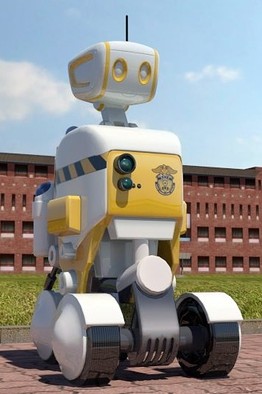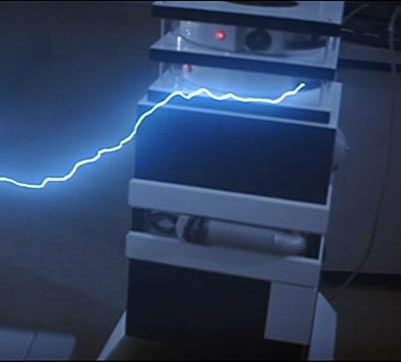Science Fiction
Dictionary
A B C D E F G H I J K L M N O P Q R S T U V W X Y Z
Korean Robot Prison Guard Is Autonomous

This autonomous robot prison guard will soon be on the job, patrolling prison corridors. The device has a number of cameras, including 3D, and has software that can assess human emotions (maybe like HAL, the computer from 2001: A Space Odyssey?).
(South Korean prison guard robot video)
Although the robot prison guard is fully autonomous, it can be remotely operated by guards using iPads, and can be used to communicate with prisoners.
I have to say that this version looks a little bit more imposing than this prison guard robot that should now be undergoing testing in Pohang, South Korea.

(Robot Prison Guard From South Korea)
Philip K. Dick was fascinated with the idea of robotic guardians; he mentions guard robots in his 1955 story The Hood Maker:
"Halt!" A robot guard appeared, streaking toward them across the field. "Identify yourselves!"Franklin showed his clip. "I'm Director level. We're here to see the Senator. I'm an old friend."
Automatic relays clicked as the robot studied the identification clip.
And don't forget the fully autonomous, terrifying claws from his 1953 story Second Variety (the basis for the 1995 film Screamers).
I also recall a similar security guard robot from Michael Crichton's 1985 movie Runaway, which also had some pacification devices built in (see below).

(Security guard robot from Runaway)
Science fiction writers have, of course, offered alternative ideas about prisons, too. Not all prisons need to have guards; consider the orbiting penal colony from William Shatner's 1989 novel Tekwar (which kept prisoners in cold sleep) and the zero-time jail from Larry Niven's 1976 novel A World Out of Time (which kept prisoners in a space in which time is stopped).
Via PCWorld.
Scroll down for more stories in the same category. (Story submitted 5/9/2012)
Follow this kind of news @Technovelgy.| Email | RSS | Blog It | Stumble | del.icio.us | Digg | Reddit |
Would
you like to contribute a story tip?
It's easy:
Get the URL of the story, and the related sf author, and add
it here.
Comment/Join discussion ( 0 )
Related News Stories - (" Robotics ")
Artificial Skin For Robots Is Coming Right Along
'... an elastic, tinted material that had all the feel and appearance of human flesh and epidermis.' - Harl Vincent (1934)
Robot Guard Dog On Duty
I might also be thinking of K-9 from Doctor Who.
Wearable Artificial Fabric Muscles
'It is remarkable that the long leverages of their machines are in most cases actuated by a sort of sham musculature...' HG Wells, 1898.
Dancing Robots Taught Dance Moves
'A clockwork figure would be the thing for you...' Jerome K. Jerome, 1893.
Technovelgy (that's tech-novel-gee!) is devoted to the creative science inventions and ideas of sf authors. Look for the Invention Category that interests you, the Glossary, the Invention Timeline, or see what's New.
Science Fiction
Timeline
1600-1899
1900-1939
1940's 1950's
1960's 1970's
1980's 1990's
2000's 2010's
Current News
The Zapata Air Scooter Would Be Great In A Science Fiction Story
'Betty's slapdash style.'
Thermostabilized Wet Meat Product (NASA Prototype)
There are no orbiting Michelin stars. Yet.
Could Crystal Batteries Generate Power For Centuries?
'Power could be compressed thus into an inch-square cube of what looked like blue-white ice'
India Ponders Always-On Smartphone Location Tracking
'It is necessary... for your own protection.'
Amazon Will Send You Heinlein's Knockdown Cabin
'It's so light that you can set it up in five minutes by yourself...'
Is It Time To Forbid Human Driving?
'Heavy penalties... were to be applied to any one found driving manually-controlled machines.'
Replace The Smartphone With A Connected Edge Node For AI Inference
'Buy a Little Dingbat... electropen, wrist watch, pocketphone, pocket radio, billfold ... all in one.'
Artificial Skin For Robots Is Coming Right Along
'... an elastic, tinted material that had all the feel and appearance of human flesh and epidermis.'
Robot Guard Dog On Duty
I might also be thinking of K-9 from Doctor Who.
Wearable Artificial Fabric Muscles
'It is remarkable that the long leverages of their machines are in most cases actuated by a sort of sham musculature...'
BrainBridge Concept Transplant Of Human Head Proposed
'Briquet’s head seemed to think that to find and attach a new body to her head was as easy as to fit and sew a new dress.'
Google's Nano Banana Pro Presents Handwritten Math Solutions
'...copy was turned out in a charming and entirely feminine handwriting.'
Edible Meat-Like Fungus Like Barbara Hambly's Slunch?
'It was almost unheard of for slunch to spread that fast...'
Sunday Robotics 'Memo' Bot Has Unique Training Glove
'He then started hand movements of definite pattern...'
Woman Marries Computer, Vonnegut's Dream Comes True
'Men are made of protoplasm... Lasts forever.'
Natural Gait With Prosthetic Connected To Nervous System
'The leg was to function, in a way, as a servo-mechanism operated by Larry’s brain...'
